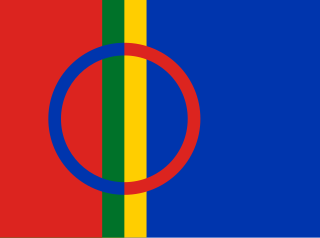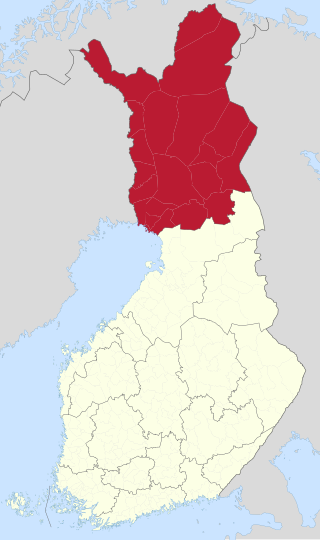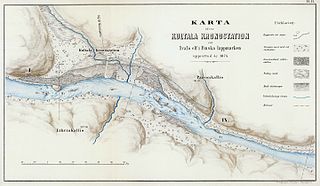
The Sámi are the traditionally Sámi-speaking Indigenous peoples inhabiting the region of Sápmi, which today encompasses large northern parts of Norway, Sweden, Finland, and of the Kola Peninsula in Russia. The region of Sápmi was formerly known as Lapland, and the Sámi have historically been known in English as Lapps or Laplanders, but these terms are regarded as offensive by the Sámi, who prefer their own endonym, e.g. Northern Sámi Sápmi. Their traditional languages are the Sámi languages, which are classified as a branch of the Uralic language family.

Sápmi is the cultural region traditionally inhabited by the Sámi people. Sápmi includes the northern parts of Fennoscandia, also known as the "Cap of the North".

Rovaniemi is a city in Finland and the regional capital of Lapland. It is located near the Arctic Circle in the northern interior of the country. The population of Rovaniemi is approximately 65,000, while the sub-region has a population of approximately 69,000. It is the 17th most populous municipality in Finland, and the 12th most populous urban area in the country.

Lapland is the largest and northernmost region of Finland. The 21 municipalities in the region cooperate in a Regional Council. Lapland borders the region of North Ostrobothnia in the south. It also borders the Gulf of Bothnia, Norrbotten County in Sweden, Finnmark County and Troms County in Norway, and Murmansk Oblast and the Republic of Karelia in Russia. Topography varies from vast mires and forests of the South to fells in the North. The Arctic Circle crosses Lapland, so polar phenomena such as the midnight sun and polar night can be viewed in Lapland.

The University of Lapland is a public university in Rovaniemi, Finland. It was established in 1979 and is the northernmost university in the European Union.
Kemi Sámi was a Sámi language that was originally spoken in the southernmost district of Finnish Lapland as far south as the Sámi siidas around Kuusamo.

Inari is Finland's largest municipality by area, with four official languages, more than any other in the country. Its major sources of income are tourism, service industry, and cold climate testing. With the Siida museum in the village of Inari, it is a center of Sámi culture, widely known as the "capital of Sámi culture".

Sodankylä is a municipality of Finland. It is located in the region of Lapland, and lies at the northern end of Highway 5 (E63) and along Highway 4 (E75). The Kitinen River flows near the center of Sodankylä. Its neighbouring municipalities are Inari, Kemijärvi, Kittilä, Pelkosenniemi, Rovaniemi, and Savukoski. The municipality has two official languages: Finnish and Northern Sami.

Inari is a population centre in the municipality by the same name in Lapland, Finland. It is widely known as the capital of Finnish Sámi culture.

Siidalit. 'the place' is a museum located on Lake Inari in the village of Inari in Inari, Finland. It is home to the Sámi Museum and Northern Lapland Nature Centre. The museum was first opened on the 1st of April 1998.

The Ivalo River is a 180-kilometre-long (110 mi) river that flows through upper Lapland into Lake Inari.

The Sámi Parliament of Finland is the representative body for people of Sámi heritage in Finland. The parliament consists of 21 elected members and 4 elected deputy members. As of 2020, the president is Tuomas Aslak Juuso.

Ukonkivi is located on the island of Ukonsaari in lake Inari, Finnish Lapland. The Inari Sami name for the island is Äijih. The area of the lake is called Ukonselkä. Ukonkivi was considered by the local Inari Sami to be an extremely important sieidi, or sacred natural formation, and was used as a sacrificial site, perhaps as recently as in the 19th century. The names "Ukko" and "Äijih" refer to sky deities in the Finnish and Sami mythologies, respectively.
Lapin Kansa is a morning newspaper published in Lapland, Finland.

Janne Antero Seurujärvi is a Finnish Sami politician. He was the first Sami ever to be elected to the Finnish Parliament. Seurujärvi represents the Finnish Centre Party (Keskusta). Seurujärvi was a member of the Finnish Parliament from 2007 to 2011. Seurujärvi is the CEO of Saariselkä ltd., one of the biggest holiday resorts in Finnish Lapland.
Leif Rantala was a Finnish-Swedish linguist, and a specialist of Sami languages, cultures of history, especially of the Kola Peninsula.

The Lapland gold rush, also known as the Ivalo Gold Rush, was a gold rush that occurred in the 1870s in Lapland, Grand Duchy of Finland, then part of Imperial Russia. The Lapland gold rush started in the valley of the Ivalojoki River in 1870 and lasted for a few years. Although the scale of the Lapland gold rush is not comparable to the major 19th century gold rushes, the Lapland gold rush has great local significance in Lapland and across Finland.

Jaakko Gauriloff is a Skolt Sámi singer. He is regarded as the first artist to have sung popular music in the Skolt Sámi language and is said to be the first Sámi to have published an album in Finland when he published his first record at the end of the 1960s. Although he is mostly known as a schlager singer, he can also sing traditional Skolt Sámi leuʹdds.
The Aalto Centre is an urban area milieu in the city of Rovaniemi, in the Finnish Lapland, designed by the renowned Finnish architect Alvar Aalto, comprising the city's key administrative and cultural buildings.
Suohpanterror is a Finland-based Sámi art and activist group. It includes a group of anonymous artists from Finland, Norway, and Sweden, producing memes and other visual arts distributed largely via social media, posters, and performance art. Suohpanterror describes its work as "artivism" with a focus on resisting "colonization and environmental injustice in Sápmi."














